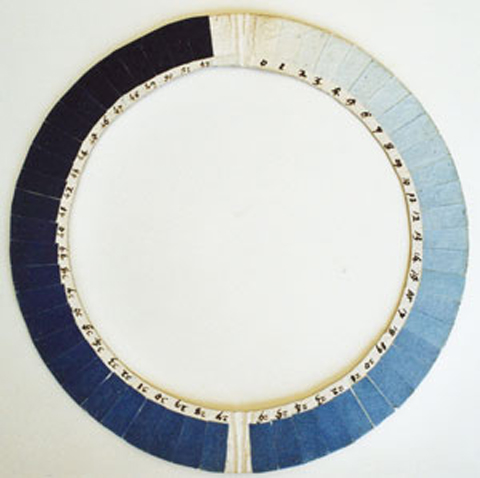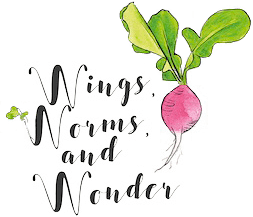Category: Montessori, Nature Art, Nature Journaling, Wonder Wednesday
Summer is on its way, and blue skies abound! So why not make a nature journaling project inspired by them? In all my years of loving all things cyan, I recently discovered the cyanometer.
What in the world is that you ask? Great question! It’s a historic device that measures the blue of the sky. Why? Well, why not? The sky has captivated humans through the ages, and back in 1789 Swiss physicist Horace-Bénédict de Saussure decided to make his own attempt at the age old question –
“Why is the sky blue?”
De Saussure was a brilliant natural scientist with a strong desire to measure things. Saussure suspected the blue of the sky was an optical effect because on different days the sky faded from a pale white gray of the clouds to a deep blue.
“…Saussure concluded that the colour [of the sky] must indicate its moisture content.” (credit)
His suspicion was correct, but to get to that conclusion, he needed a tool to measure the sky – enter the cyanometer!

Horace-Bénédict de Saussure’s cyanometer from 1760.
So Saussure created a dial of 53 tints and shades of prussian blue to use as a meter for tracking the blue of the sky. He hoped that this tool would help further accuracy in the field of meteorology and weather prediction. While the cyanometer didn’t help so much with that, the work he accomplished with did it help earn Saussure the title of founder of modern meteorology.
The cyanometer is a useful too for nature journalers and those interested in tracking and documenting the natural world around them. De Saussure concluded, correctly, that the color of the sky was dependent on the amount of suspended particles in the atmosphere
In the end, was Lord Rayleigh and Gustav Mie who scientifically answered why the sky is blue, but De Saussure’s discovery of cyanometer proves to this day to be a tool that can help inspire natural historians and artists alike to track, replicate, and ponder the blues of the sky.
Wonder Wednesday 81:
Make a Cyanometer
Create your own cyanometer and track blue skies throughout the seasons in your nature journal. Discover what wonders reveal themselves to you over time!
If you want to do this activity with little ones, I have a modification for you in the “Extensions” section.
Materials:
- Watercolor paper 150-300 lbs is best because you want that stiffness
- 2 concentric bowls – or if you want to include geometry lessons into this activity, break out the compass, protractor, and your circle formulas!
- Pencil
- Ruler
- Scissors
- Paint brush and water
- Prussian Blue watercolor paint and palette
- Scratch paper and paper towel
- Clothes pin (or popsicle stick and tape)
Preparation of the Cyanometer:

Trace your larger bowl onto your paper. Then trace the smaller bowl inside. Try to center the smaller inner bowl as well as possible if you are eyeballing it like I did. Or, if you are using geometry tools and formulas, make them exactly centered.
Then, find the center of the circle (eyeballing like me or geometrically) and use the ruler to draw vertical and horizontal lines through the center.

Continue splitting the circle up into pieces by drawing the lines (again eyeballing like me or geometrically). You can decide how many pieces you want to make. I chose 16 pieces.

Cut out the outer, larger, circle from the paper. Carefully poke a hole in the very center and then cut out the inside of the circle just under your numbers – you can do this precisely or just eyeball it like I did.

Use a waterproof pen like a thin sharpie or a pigma micron pen to number just to the inside circle of each piece.
Painting Procedure:
Get 2 cups of clean water. One will stay mainly clean and one you will use for fading the blue. Have your paper towels and scratch paper handy.
Now, prepare a clean paint palette with only Prussian Blue watercolor paint. A white palette works best for creating these gradations.

At this point, if making monochromatic gradation swatches is new to you, practice making different saturations on scratch paper.
Do this by starting with very diluted paint added to your wet brush and paint your lightest grade and gradually add a bit more paint to saturate each gradation until you use just enough water to make the paint flow.
Then, do the same on your wheel. Decide if you are more comfortable going light to dark or vice versa and begin. I personally tend to always start lighter because it’s easier to add more paint than to take it away.
Make swatches that grade from nearly white at 1 to nearly black at 16 (or your highest number). Use your scratch paper to test your color next to the pervious swatch to make sure you got it about right before placing it down.

You may need to daub off some paint if you went a little too dark while painting, or go back and do a second layer once it drys if you need to go a little darker on any particular swatches.
Let the swatches dry completely.

I’d say the sky falls between 10-11 today, but if I shift over to the cloudier area it’s more like a 6.
Clip the clothes pin in between swatches at the bottom of your cyanometer. (Or tape a popsicle stick to the back.)
Go outside and see where the day’s sky falls on the meter and begin your sky tracking adventure!
Extensions
Keep your cyanometer in your nature journal and use it as part of your tracking system with your date and time.
Create a “sky journal” and document all your sky observations across the seasons and times of day. Over time, could this help you discover how the blues of the sky could attune your awareness to weather. (ex.- very cold days quite often have very blue skies)
Use this to help you paint skies in your creative nature connections. Looking at the sky through your cyanometer can help you discover where the sky should be lighter or darker in your landscape paintings.

Have you noticed how the blues of the sky can depend on where you are in the world? If you go on a trip, create the “preparation” steps for a cyanometer before you go, tuck it into your travel nature journal, and create one based on the color blue of the sky where you are. Perhaps you need to make it from cobalt, ultramarine, or aquamarine instead of prussian blue?
Use this with young children to discover how many blues they can find in the sky. If children are too young to paint, gather paint sample chips in blues and create smaller cyanometers by having them arrange the chips in a light to dark gradient and glue them onto a circle. In a Montessori classroom the color tiles work can be used as a preparation activity for creating a cyanometer.
What’s your favorite thing about a blue sky day?
Share in the comments below!
Share your outdoor blue sky with your cyanometer pics on Instagram #wingswormsandwonder!
Seeds to Sprout:

